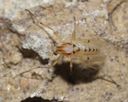Tanypodinae
Tanypodinae
Classification
- Phylum: Arthropoda
- Subphylum: Hexapoda
- Class: Insecta
- Order: Diptera
- Infraorder: Culicomorpha
- Family: Chironomidae
- Subfamily: Tanypodinae
Pronunciation
How to pronounce Tanypodinae: //ˌtænɪˈpɒdɪniː//
These audio files are automatically generated. While they are not always 100% accurate, they are a good starting point.
Images






Summary
Tanypodinae is a subfamily of non-biting midges (Chironomidae) characterized by specific wing vein structures and carnivorous larvae, contributing to ecosystem dynamics as predators of small invertebrates.
Physical Characteristics
Generally less than 5mm in size. Wing veins are distinct, with R2 branching off R1, and M-Cu crossvein present. Females have antennae with more than ten segments. Larvae have retractile antennae and unique head structures. They may have longer heads, prolegs, and a fringe of long hairs along the sides of the abdomen.
Identification Tips
Look for distinctive wing vein structures: R2 branching off R1 and the presence of an M-Cu crossvein. In adults, the hairy wings and usually non-extended costal vein past the last branch of R are distinguishing features.
Habitat
Found in aquatic environments suitable for larval development, often in still or slow-moving waters.
Distribution
Approximately 150 species in North America, with seven tribes worldwide and six in North America.
Diet
Primarily carnivorous as larvae, predating on small invertebrates, including other chironomid larvae, while 1st and 2nd instar larvae may feed on algae.
Life Cycle
Life cycle stages include egg, larval, pupal, and adult phases. Larvae are usually the longest developmental stage.
Reproduction
Information on specific reproductive habits not detailed, but usually involves aquatic eggs laid by females.
Predators
Predatory larvae may be preyed upon by larger aquatic invertebrates and fish.
Ecosystem Role
As predators in aquatic ecosystems, they help control populations of small invertebrates.
Collecting Methods
- Light trapping
- Aquatic net collection
Preservation Methods
- Ethanol preservation
- Drying for morphological studies
Similar Taxa
Misconceptions
Often mistaken for biting midges, but they are non-biting.
Tags
- Tanypodinae
- Midges
- Non-biting
- Aquatic insects